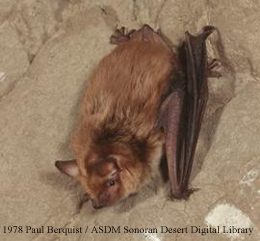Animal Fact Sheet: Big brown bat |
Identifying Features Big brown bats (Eptesicus fuscus) are considered "large" for an American bat. They have brown to glossy copper-colored fur on their back with the belly fur being lighter. Their ears are small, rounded and black in color as are their wing membranes and tail. Their lips are fleshy and their nose is broad for the size of their face.
|
 |
Migration/Hibernation These bats are so widespread because they are very hardy and can withstand conditions that other bats can't. Those that hibernate will do so in caves, mines, walls, attics or other buildings. Some may migrate short distances to find an appropriate location for hibernating. |
Habitat The big brown bat is found in almost all habitats from deserts, meadows, cities, to forests, mountains and chaparral. |
Range They range from the extreme northern parts of Canada through the United States, Mexico, Central America, northern South America and the Caribbean Islands. |
Wild Status Big brown bats are considered common and are currently not of any special conservation concern. |
Diet These bats are insectivorous. They prefer eating beetles over other insects, using their powerful jaws to chew through the beetles' hard exoskeleton. They will also eat other flying insects including moths, flies, wasps, and flying ants all of which they capture while in flight. |
Predators Big brown bats choose their roosts for many reasons, one being to protect themselves from predators. These predators will often take the pups if they have fallen on the ground. Cats, snakes, and raccoons will search maternity roost sites for such pups. Flying bats can be predated upon by owls as they leave their roosts. |
Reproduction Female big brown bats form nursery colonies to rear young. The size of these colonies can vary, but usually fall within the range of 20 to 300 animals. Bachelors roost alone or in small groups during this time. Big brown bats mate during the fall and winter before they go into hibernation, but the female does not become pregnant until the spring as she stores the sperm during hibernation. In late May or early June she gives birth to one or two pups. The babies are born blind, with no fur and completely depend on their mother for nourishment. They grow quickly and are able to fly within a month to six weeks. |
Life Span Big brown bats can live up to 18-20 years in the wild. Unfortunately most big brown bats die during their first winter because they did not store enough fat to survive through their entire hibernation period. |
Size Their average weight is 0.5-1.2 oz (14-21 gm's). Their wingspan is 12-16 inches (32-40 cm). |
Extra Fun-facts
|










